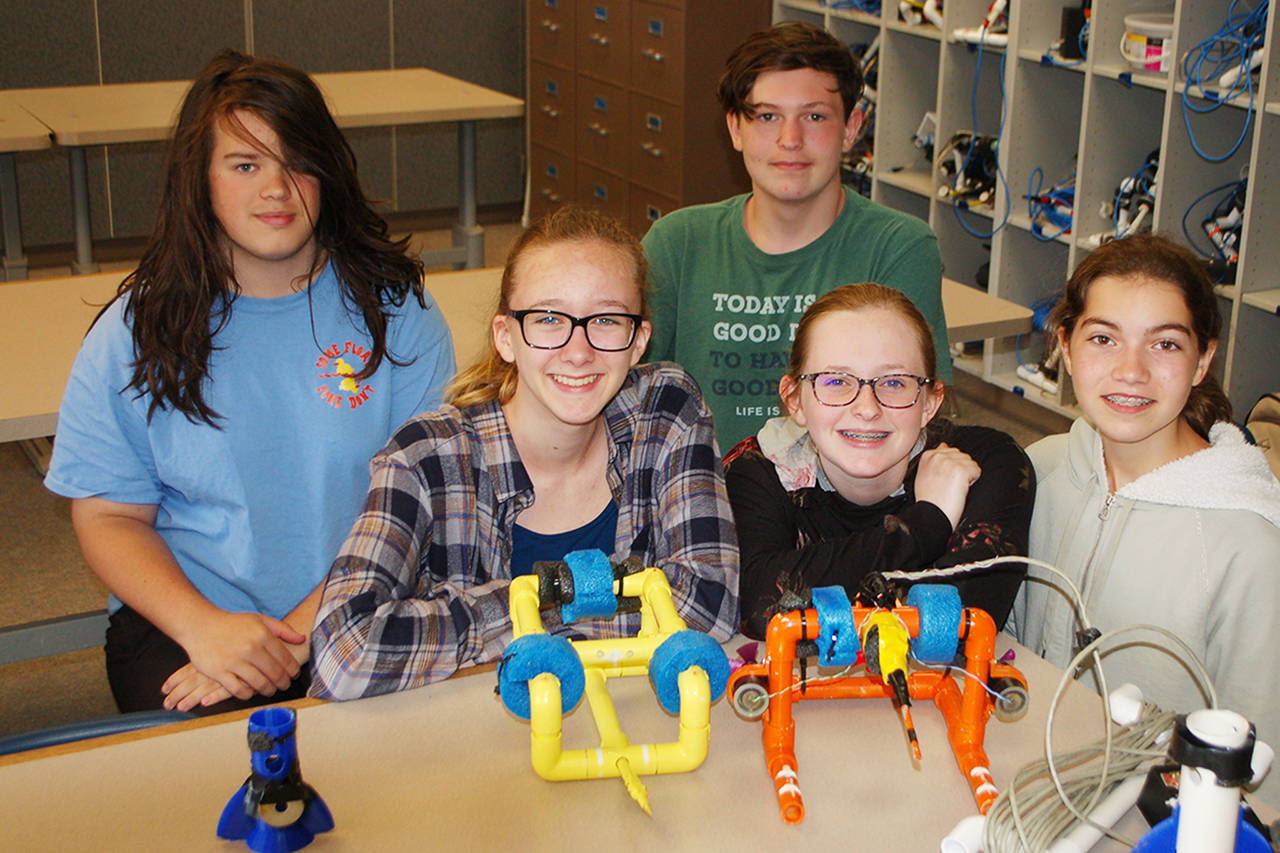A group of Sequim Middle School robotics students made some school history this spring, winning a regional competition and becoming the first Sequim students to compete in the SeaPerch national finals.
The SeaPerch Challenge is an annual event encouraging students to design and operate underwater robotic vehicles. Sequim Middle School students Ruby Coulson, Finn Marlow and Desmond Tippins won their regional competition on April 27, while another SMS team of Julia Jeffers and Kari Olson placed second.
With the recommendation of SMS teacher-advisor Caleb Gentry, the two teams combined for the SeaPerch national competition in June. Despite having just a month to prepare, team members said they felt like they did well.
“We had a lot less time to get ready than other teams did,” Coulson said, mentioning that many other teams at nationals had regional competitions in January or February, giving them more time to design, test and refine designs their remote operated vehicle (ROV), working with the national competition framework.
The national competition for SeaPerch featured 96 teams at the middle school level, as well as high school and “open” competition categories. Qualifying teams had to win or perform high at regional competitions all over the world, with nearly 6,000 teams taking part in earlier stages worldwide — including teams from as far away as Australia — before getting to the nationals in Maryland on June 1 and 2.
This year’s competition was based around the 2018 rescue of students from a cave in Thailand that was filling with water. That rescue was complicated by the nature of the subterranean environment and water, inspiring SeaPerch organizers to create challenges based on overcoming that kind of situation.
“We basically lived at Kari’s house for a few weeks,” Marlow joked — although Olson’s family was able to provide valuable resources for the team. Olson’s father Taylor Olson is a naval architect and gave students full use of his well-stocked workshop and the guidance on how to properly use what they needed, team members said.
The team also had to overcome some specification issues after getting some incorrect national competition guidelines, including different material composition and obstacle sizes on courses, wiring specifications and sizing on course components. Fortunately, team members said, they were ready to adjust “on the fly” with some quick modifications and a fortuitous decision to grab an extra, smaller version of one component.
Not everything would go smoothly in competition for the SMS students, however: an issue with one of three propellers on the ROV slowed them down significantly in the obstacle course, and their mission course was hampered by their communications tether snagging on a barrier made of a glossy material on which the cable got stuck.
The students and Gentry were disappointed in those setbacks that saw the SMS team place 62nd overall out of 96 teams. If the competition had gone as their practices did, they said, they would have finished much higher.
For their first time competing at that level, team members said they were happy with both the experience and outcome.
“Would we do this again? Absolutely,” Coulson said.
Marlow added that he would only do SeaPerch again with these teammates — a sentiment his teammates seemed to share.
Coulson, Marlow, Tippins, Jeffers and Olson are all moving on to high school next year, but said they plan on continuing to learn about robotics and competing. For a future competition, the team mentioned the Sea, Air and Land Challenge — a competition that adds land and air based elements to what they’ve already done with SeaPerch — though they also all spoke of wanting to help future SeaPerch teams at Sequim Middle School.
For his part, Gentry expressed a lot of pride in his students.
“One of the buzz word in education the last few years has been ‘growth mindset,’” he said. “Students who participate in the SeaPerch challenge can develop this attribute and approach to learning in a positive way.
“A closely related term is ‘grit,’” Gentry added, “which is also a characteristic that can be developed thought involvement in project-based learning where students overcome challenges, and with SeaPerch challenge there all always problems to overcome. Together, growth mindset and grit are a winning formula.”
Gentry noted that competitions like SeaPerch are important for students learning how to overcome adversity.
“Teamwork is hard,” he said. “Students can struggle with this facet of the challenge (and it’s easy to ignore) but it’s also one of the key skills they will need for the future. Intentionally modeling and teaching how to be a good teammate is important for a successful experience.”



